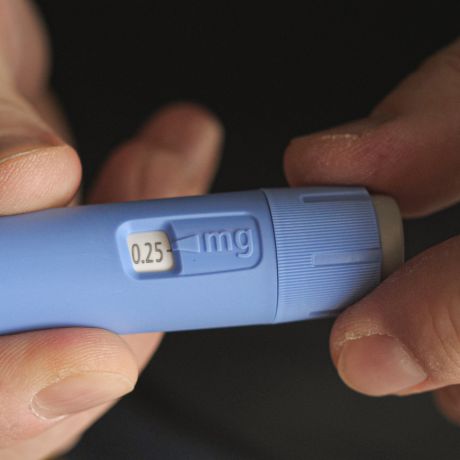Over the past decade, diabetes has reached epidemic proportions, but advances in medical research consistently give people struggling with this chronic ailment fresh hope. One such development is Ozempic, a ground-breaking drug in the type 2 diabetes therapy toolbox.
Ozempic is the most popular brand name for the medication semaglutide. Thanks to its effectiveness in controlling blood sugar level in diabetics, it has become a source of hope for millions of patients worldwide. It's also grown in popularity for those without diabetes simply looking to lose weight. However, as with any medical procedure, Ozempic has its intricacies, and concerns about its potential adverse effects still exist.
One recurrent topic jumps out among the issues expressed by people considering Ozempic: Does semaglutide cause headaches?
That's the question we tackle in this article, with an in-depth exploration of the scientific environment surrounding semaglutide and its conceivable connection to headaches.
Table Of Contents
- Short-Term And Long-Term Side Effects
- Can Semaglutide Unlock Your Weight Loss Journey?
- How Semaglutide Works For Weight Loss
- Who Should Take Semaglutide?
- Accessing Semaglutide For Weight Loss
- FAQs

Short-Term And Long-Term Side Effects
Short-term Ozempic risks & side effects include:
- Nausea, Severe Stomach Pain, Diarrhea, Vomiting: These symptoms typically subside once the body gets used to the drug.
- Hypoglycemia: Semaglutide won't induce hypoglycemia (low blood sugar) by itself but may do so when used along with such diabetes drugs as insulin and sulfonylureas.
- Injection Site Pain: Semaglutide is provided by subcutaneous injection, and some people may suffer slight pain, redness, or edema where the medication was injected.
- Loss Of Appetite: Semaglutide users occasionally report a drop in appetite, which can aid in weight loss but also impact food habits in general.
Potential long-term side effects of semaglutide use are as follows:
- Thyroid Tumors: Semaglutide has been linked to increased thyroid cancer incidence in female rats. However, it is not clear that these effects also relate to humans.
- Pancreatitis: There have been a few reports that administration of GLP-1 receptor agonists has led to inflammation of the pancreas (pancreatitis). Symptoms of this condition include nausea, stomach pain, and vomiting. If you experience them, seek medical attention immediately.
- Gallstones: Some people may be more susceptible to gallstones while taking semaglutide.
- Renal Function: Semaglutide may influence renal function, so regular monitoring of renal function is advised.
- Allergic Reaction: Serious allergic reactions to semaglutide are very rare, but they are a possibility. Symptoms include a skin rash, breathing difficulty, and swelling of the lips and tongue.
Can Semaglutide Unlock Your Weight Loss Journey?
Semaglutide was originally developed to treat type 2 diabetes. Classified under a category of medications called GLP-1 RAs (glucagon-like peptide-1 receptor agonists), it regulates hunger and helps with blood sugar control.
Researchers noticed an unexpected effect during clinical studies of its ability to lower blood sugar levels: patients lost a substantial amount of weight. This finding sparked additional research into semaglutide's potential as a weight-loss drug.
As such, the ability of semaglutide to help people lose weight has been investigated in a number of clinical trials. The STEP 1 experiment, a landmark study, comprised patients who were overweight or obese but did not have diabetes. Throughout the experiment, those who got semaglutide as a subcutaneous injection lost an impressive 15% of their body weight on average. This result was noticeably better than what is generally accomplished with lifestyle changes alone.
Since, semaglutide has been found to act as a weight loss medication in three ways:
- Semaglutide appears to suppress appetite, which results in a reduction in caloric intake. People who experience this impact may choose healthier foods and limit their portions.
- Semaglutide can slow down the stomach's emptying, promoting feelings of fullness and lowering the desire to eat between meals.
- Semaglutide is thought to boost energy expenditure, enabling the body to burn more calories.
Although semaglutide has potential as a weight-loss tool, it is important to use it carefully and under a doctor's supervision. Compared to the amount indicated for treating diabetes, the medicine is often prescribed in greater doses for weight loss. Make sure to extensively explore potential side effects and contraindications with a healthcare professional.

How Semaglutide Works For Weight Loss
Several physiological processes that affect hunger, calorie intake, and energy expenditure are part of the mechanism of action for weight reduction with semaglutide. Let's break them down:
1) GLP-1 Receptor Agonization
Semaglutide is a GLP-1 receptor agonist (GLP-1 RA). The GLP-1 hormone, produced in the intestines, significantly controls hunger and blood glucose balance. Semaglutide attaches to GLP-1 receptors and mimics the actions of the hormone (1).
2) Suppression Of Appetite
Semaglutide inhibits the sensation of hunger by activating GLP-1 receptors in the brain's centers for appetite. This impact can suppress appetite, which may result in fewer calories consumed and weight loss as a result.
A 2017 double-blind placebo-controlled study gave 1 mg of subcutaneous semaglutide to 30 obese people over 12 weeks. Compared to a placebo group, the semaglutide group consumed significantly less food during all meals, with a 24% reduced caloric intake over the study period (2).
3) Delayed Gastric Emptying
Semaglutide can delay the gastric motility process, which causes the stomach to empty more slowly. As a result of the delayed stomach emptying, you feel fuller for longer and have less appetite, which helps you eat less (3).
In one study examining the effect of glucagon-peptide-1 on gastric emptying, eighteen men were given either GLP-1 or a saline placebo. Gastric emptying was measured using paracetamol as a marker and emptying rates were seen to be lower in the GLP-1 group (4).
4) Improved Insulin Sensitivity
Semaglutide may enhance insulin sensitivity, enabling cells to absorb glucose from the bloodstream more efficiently. Better blood sugar management and indirect weight management may both be supported by improved insulin sensitivity (5).
5) Potential Enhancement In Energy Expenditure
Although the particular mechanism is not entirely known, several studies indicate that GLP-1 RAs like semaglutide may enhance energy expenditure, enabling the body to burn more calories.
A 2001 study examined how a dose of glucagon-like peptide-1 (GLP-1) infusion affected feelings of hunger and energy metabolism. The findings demonstrated that GLP-1 infusion decreased sensations of hunger and potential post-breakfast food consumption (6).
Furthermore, it dramatically reduced stomach emptying rate, glucose oxidation, and resting metabolic rate. This shows that GLP-1 may help with weight loss by successfully slowing the pace at which nutrients enter the bloodstream.
6) Reduced Emotional And Reward-Based Eating
Semaglutide may affect brain areas involved in emotional and reward-based eating behaviors (7). Changing how people perceive food rewards can result in lower consumption of calorie-dense, appealing foods.

Who Should Take Semaglutide?
If you're considering taking Ozempic semaglutide for weight loss, here are a dozen considerations to take into account to help you make an informed decision:
- Speak With A Healthcare Professional: Make an appointment for a thorough consultation with a healthcare professional, preferably one with experience in diabetes or weight management, before beginning semaglutide for weight loss. Talk about your medical history, present health, and weight loss objectives.
- Determine Qualification: Based on your body mass index (BMI) and any underlying medical issues, your healthcare practitioner will determine whether semaglutide is a good fit for you.
- Examine Additional Options: Look into other weight loss techniques with your healthcare physician. These could include behavioral therapies, dietary modifications, and increased physical activity. Only when previous methods have not produced the intended outcomes should semaglutide be considered.
- Recognize The Advantages: Clinical trials on semaglutide have demonstrated that it causes considerable weight loss. Recognize that using it may significantly enhance your weight, metabolic health, and general well-being.
- Talk About Possible Risks: Semaglutide may have dangers and side effects, including gastrointestinal problems, the possibility of thyroid tumors (most often reported in animal trials), pancreatitis (albeit rare), and gallbladder and kidney problems. The potential advantages need to be compared to these risks.
- Establish Reasonable Goals: Discuss reasonable expectations for weight loss with your doctor. Even though semaglutide can provide substantial weight loss, individual outcomes may differ.
- Dosage And Surveillance: Together with your healthcare professional, determine the proper semaglutide dosage. When compared to managing diabetes, weight loss often requires higher doses. Create a monitoring plan to monitor your progress and assess any severe side effects beforehand.
- Supplemental Lifestyle Modifications: Recognize that a good diet and frequent exercise are best coupled with semaglutide for maximum effectiveness. You can develop a personalized plan with the aid of your healthcare provider or take a look at How To Successfully Use Meal Preparation For Weight Loss and the 6 Best Fat Burning HIIT Workouts For Weight Loss.
- Repeated Follow-Up Visits: Make a commitment to visit your doctor for follow-up appointments frequently. These visits are crucial for tracking how the drug works, addressing any issues, and making any necessary modifications.
- Individualized Strategy: Recognize that using semaglutide should be a very individualized choice. Your particular health profile and weight control requirements will be taken into account by your healthcare provider.
- Continuous Communication: Throughout your semaglutide treatment, keep the lines of communication with your healthcare practitioner open and honest. Immediately report any unusual or severe adverse effects.

Accessing Semaglutide For Weight Loss
Here are the steps you need to follow if you intend taking semaglutide for weight loss:
1) Consulting a Healthcare Professional
The first step in obtaining semaglutide for weight loss is speaking with a healthcare professional. Find a healthcare provider specializing in endocrinology, diabetes, or weight control.
In the course of this initial consultation, make sure to do the following:
- Talk about your history and goals for weight loss. Give a thorough medical history that includes any underlying health issues.
- Tell them about the drugs you're taking now, your allergies, and your lifestyle choices.
- Based on your BMI, medical history, and general health, your healthcare practitioner will determine whether semaglutide is acceptable for your weight control requirements.
2) Eligibility Assessment
Your healthcare practitioner will determine whether you are eligible for semaglutide by taking into account variables like:
- Body Mass Index: Semaglutide is frequently administered to patients with a BMI above a predetermined cutoff, usually 30 or higher, or 27 or higher in patients with concomitant conditions such as type 2 diabetes.
- Existence of Comorbidities Associated With Obesity: Your doctor will determine whether you have any conditions like diabetes, high blood pressure, or high cholesterol that are linked to obesity.
3) Discussion Of Available Alternative Treatments
Your healthcare professional will go over various weight-management alternatives, such as dietary and activity modifications, behavioral treatments, and medication. Semaglutide should only be pursued if other methods have failed to provide the desired weight loss.
4) Writing The Prescription
If it's determined as the best option for you, your doctor will write a prescription for semaglutide and decide on the right dosage.
5) Monitoring Strategy
Your doctor will create a dose or medication schedule to keep tabs on your development. Regular follow-up appointments to evaluate weight loss, side effects, and general health may be part of this.
6) Get Semaglutide From a Drugstore
After all of the discussion takes place and you have your prescription ready, you can pick it up from a drug store. Semaglutide is commonly administered as a subcutaneous injection, so be sure you know how to administer and keep the medication appropriately.
For more information about storage, read Should Ozempic Be Refrigerated?

FAQs
Let's look at some more of your questions about the side effects of semaglutide.
Why am I getting headaches on Ozempic?
Some people may feel headaches at the beginning of their Ozempic treatment. These headaches could be a side effect of the medication's body-adjusting process and should improve as your body adjusts to it.
Ozempic is primarily used to control blood sugar levels, and it can result in better glucose regulation. Ozempic headaches may result from your body adjusting to variations in blood sugar levels if they are quickly stabilizing or declining.
How do you get rid of a semaglutide headache?
If you are getting headaches from taking Ozempic, we suggest the following:
- Hydrate: Make sure you are taking in plenty of water, as dehydration contributes to headaches.
- Try over-the-counter pain relief medication such as Ibuprofen or Advil
- Get plenty of rest, ideally in a quiet, dark environment.
- Engage in stress reduction practices such as deep breathing, meditation, or yoga.
- Keep a headache diary to identify triggers.
- Adjust your medication, but only do this in conjunction with your doctor.
Do headaches from Ozempic go away?
Yes, headaches from Ozempic usually go away within a couple of weeks once the body has adjusted to the medication. If your headaches persist beyond two weeks, you should see your doctor.
What are the most common side effects of semaglutide?
The most common side effects of semaglutide are:
- Nausea
- Abdominal pain
- Vomiting
- Diarrhea
- Constipation
- Dizziness
- Injection site reactions
- Hypoglycemia (low blood pressure) when taken along with some diabetes medications
Summary Of Semaglutide And Headaches
Semaglutide offers hope for people seeking practical solutions to obesity. Its remarkable impact on weight loss, demonstrated through clinical trials and real-life success stories, underscores its potential to transform lives.
However, as with any medication, Semaglutide is not without its risks. Its side effects, including gastrointestinal symptoms and the need for injection, require thoughtful evaluation and management. Individual responses can vary, and a healthcare professional should guide its use.

References
- Pi-Sunyer, F. X. (2014). Medical treatment of obesity. JAMA, 312(9), 983-984.
- Blundell J, Finlayson G, Axelsen M, Flint A, Gibbons C, Kvist T, Hjerpsted JB. Effects of once-weekly semaglutide on appetite, energy intake, control of eating, food preference and body weight in subjects with obesity. Diabetes Obes Metab. 2017 Sep;19(9):1242-1251. doi: 10.1111/dom.12932. Epub 2017 May 5. PMID: 28266779; PMCID: PMC5573908.
- Vilsbøll T, Christensen M, Junker AE, Knop FK, Gluud LL. Effects of glucagon-like peptide-1 receptor agonists on weight loss: systematic review and meta-analyses of randomised controlled trials. BMJ. 2012 Jan 10;344:d7771. doi: 10.1136/bmj.d7771. PMID: 22236411; PMCID: PMC3256253.
- Flint A, Raben A, Ersbøll AK, Holst JJ, Astrup A. The effect of physiological levels of glucagon-like peptide-1 on appetite, gastric emptying, energy and substrate metabolism in obesity. Int J Obes Relat Metab Disord. 2001 Jun;25(6):781-92. doi: 10.1038/sj.ijo.0801627. PMID: 11439290.
- Once-weekly semaglutide in adults with overweight or obesity. (2021). New England Journal of Medicine, 385(1). https://ift.tt/qKm60uS
- Flint A, Raben A, Ersbøll AK, Holst JJ, Astrup A. The effect of physiological levels of glucagon-like peptide-1 on appetite, gastric emptying, energy and substrate metabolism in obesity. Int J Obes Relat Metab Disord. 2001 Jun;25(6):781-92. doi: 10.1038/sj.ijo.0801627. PMID: 11439290.
- Farr, O.M., Sofopoulos, M., Tsoukas, M.A., Dinçer, F., Thakkar, B., Sahin-Efe, A., Filippaios, A., Bowers, J.G., Srnka, A., Gavrieli, A., Ko, B., Liakou, C., Kanyuch, N., Tseleni-Balafouta, S., & Mantzoros, C.S. (2016). GLP-1 receptors exist in the parietal cortex, hypothalamus and medulla of human brains and the GLP-1 analogue liraglutide alters brain activity related to highly desirable food cues in individuals with diabetes: a crossover, randomised, placebo-controlled trial. Diabetologia, 59, 954-965.

0 Comments